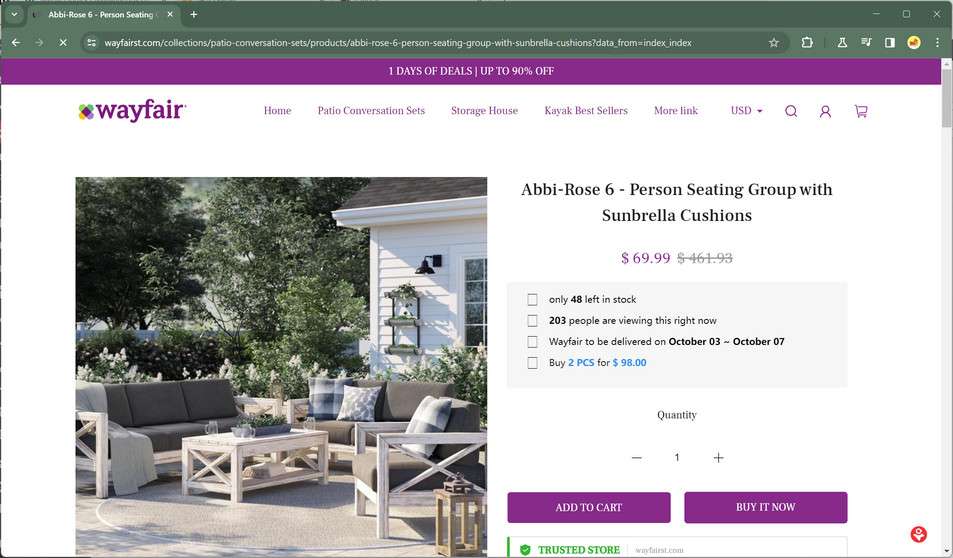Online shopping brings convenience but also attracts scammers looking to take advantage of unwary shoppers. One such scam making the rounds is the fake Wayfair clearance sale offering up to 90% off on furniture and home goods.
This detailed guide will uncover how the Wayfair scam works, provide tips to avoid being duped, and help victims recover from the fraud.



Overview of the Wayfair 90% Off Scam
Online shopping brings convenience but also provides fertile ground for scammers to take advantage of unwary shoppers. One prolific scam making the rounds targets furniture and home goods lovers with fake Wayfair clearance sales advertising eye-popping discounts of up to 90% off.
This deceptive scheme capitalizes on Wayfair’s reputation as a one-stop shop for stylish, affordable home furnishings. Scammers create sophisticated fake websites designed to mimic Wayfair’s real site in order to trick customers into thinking they’re getting unbelievable deals on name brand merchandise. However, the rock-bottom prices, like a $3,000 sofa for $99 or a rug for $49 rather than $499, are clearly too good to be true.
These fraudulent sites are intentionally designed to dupe consumers by using Wayfair’s official branding, logos, fonts, colors, and messaging. Stock photos of home goods are stolen from other sites to make the fake product listings seem more realistic. After luring victims in with their exaggerated discounts, these sham sites take shoppers’ money but never deliver the promised goods.
This predatory scam has been heavily promoted on Facebook, Instagram, TikTok, and across the internet using paid ads targetingdeal-seeking shoppers. Scammers have optimized the scheme to maximize views by using enticing captions claiming “50-90% Off,” “Going Out of Business Sale,” and “Last Chance Clearance.”
The prevalence of this scam across social media demonstrates scammers’ ability to quickly duplicate successful techniques to rip off as many consumers as possible. They capitalize on the fear of missing out triggered by time-limited sales and extreme price cuts.
For example, one recent incarnation of the scam used a Facebook ad campaign touting a 90% off Christmas sale with name brand tree skirts for only $3 and stockings for just $1. Of course the prices were fictitious, but they successfully lured in victims ready to check off their holiday decor shopping lists.
Another variation touted a “Warehouse Clearance” event with rustic farmhouse coffee tables discounted from $350 down to just $39. Suckered shoppers were left empty-handed when the fictional sale concluded, and the fraudulent site vanished without a trace.
Stay vigilant when shopping online, especially for deals that seem too good to pass up. Be skeptical of any site you’re not familiar with and watch out for the red flags detailed in this guide. Don’t let a scam cost you hard-earned money and permanently sour your online shopping experience.
How the Wayfair Clearance Sale Scam Works
The Wayfair clearance scam ensnares victims in a process designed to convince shoppers the site is legitimate. Here’s an overview of how the fraudulent scheme works:
Step 1: Fake Website and Ads
The scammers first set up a website designed to mimic Wayfair’s real site. The fake site reproduces branding elements like Wayfair’s logo, fonts, colors, and overall aesthetic. Stock photos of home goods are stolen from other sites to populate the product listings.
To drive traffic to their sites, scammers run online ads promoting huge markdowns on Wayfair goods. These ads appear on Facebook, Instagram, and across the internet keyed to search terms like “Wayfair sale.”
Step 2: Phony Claims of Discounts
The fake sites lure in victims with claims of clearance discounts up to 90% off Wayfair products. Common slogans used include “Warehouse Sale,” “Outlet Store,” and “Store Closing Sale.”
Prices seem unbelievably low, like a $3,000 sofa for $99 or a rug for $49 rather than $499. The scammers bank on the deals being enticing enough that shoppers overlook the other red flags.
Step 3: Shoppers Place Orders
Duped shoppers place orders on the site expecting Wayfair-quality furniture at clearance prices. The site asks for all the usual order info including name, shipping address, email, and payment card details.
Various reasons are given for the deep discounts like overstock or slight product defects. In reality, there is no inventory or affiliation with Wayfair.
Step 4: No Products Are Delivered
After submitting payment and order details, victims find out they’ve been scammed when no products ever arrive. The sites disappear quickly, and emails sent to the company bounce back undelivered.
In other cases, victims receive cheap knockoff items that in no way match the advertised product. Either way, shoppers are left empty handed without any furniture or refund.
Step 5: Fraudsters Disappear
Once they’ve collected payment info and placed orders, the scammers take the money and run. Websites vanish within days, making it impossible for victims tocontact the “company.” Email addresses stop working, and no customer service exists.
The fake sites lack any transparency about who owns or operates them. Without real identities or traceable info, scammers evade accountability and keep scamming more victims.
8 Ways to Identify the Wayfair Sales Scam
Scammers are masters at creating knockoff websites that look legit. But upon closer inspection, red flags emerge indicating shady activity. Protect yourself by watching out for these tell-tale signs of a fraudulent Wayfair sale:
1. Unbelievable discounts up to 90% Off
Genuine retailers like Wayfair have sales, but prices that seem too good to be true usually are. The scammers bait customers with unrealistic markdowns knowing people’s weakness for a great bargain.
2. No Way to Contact the Company
Scammers make sure it’s impossible to call, email, or otherwise contact their fake companies. The sites only list dubious email addresses that lead nowhere.
3. No Social Media Presence
Most real brands maintain profiles on Instagram, Facebook, and other networks. Lack of social ties indicates fraudsters hastily threw up a site to scam victims.
4. Brand New Domain Names
Scam sites use new domains often registered just weeks or days before the fake sale. Genuine retailers use established sites that have been around for years.
5. Copycat Templates and Images
Scammers lift content like product descriptions, site design, and images from authentic sites. Templated content and stolen photos point to a fraudster’s handiwork.
6. Vague Claims About Discounts
If a sale seems real but details are sparse, proceed with caution. Savvy retailers offer transparency about why discounts are being offered.
7. Mismatched Headquarters Address
The scam’s listed business address doesn’t match the real company’s headquarters. This disconnect signals an illegitimate operation.
8. Poor Writing and Site Construction
Sloppy writing with grammatical errors and spelling mistakes indicates scam artists hastily constructing sites. Authentic brands post professionally written content.
How to Spot the Scam on Social Media
The Wayfair clearance scam proliferates on social media platforms like Facebook, Instagram, and TikTok through the use of eye-catching ads, enticing captions, and stolen media. Here’s what to watch out for on each platform.
Identifying the Scam on Facebook
On Facebook, the scam ads follow a familiar formula meant to entice deal-seeking shoppers.
- They lead with attention-grabbing phrases like “90% Off Clearance Sale” or “Warehouse Liquidation Sale.”
- The accompanying ad image shows a room decked out with stylish, name-brand furniture at a fraction of typical prices. For example, a $1,000 coffee table listed for just $99.
- Other frequent captions used include “Store Closing Sale,” “Today Only,” and “Free Shipping.”
- The page or group running the ads was often just created recently and has little engagement or followers. This indicates a scam account rather than Wayfair’s real Facebook business page.
- Clicking the link goes to a fake Wayfair-branded website with absurd prices on home goods. For instance, area rugs advertised at $49 rather than $499 retail value.
Essentially the scam ads on Facebook leverage unrealistic prices and a sense of urgency to get shoppers to bite before scrutinizing the details behind the “sale.” Stay alert for these tactics and other red flags covered earlier to avoid being swindled.
Spotting the Instagram Wayfair Scam
On Instagram, scammers use posts showing enticing home goods as bait coupled with captions promising clearance steals.
- The images show furniture and decor like sofas, dining sets, pillows, and wall art. Oftentimes the photos appear edited onto a stock background image.
- The captions contain limited-time appeals like “Going Out of Business Sale – Today Only!” Or exaggerated price cuts like “Entire Store 90% Off.”
- Comments are disabled on the posts to suppress negative feedback about an obvious sham.
- Clicking the Instagram bio link goes to a sketchy “Wayfair” site unrelated to the real company.
- The account lacks any other posts and does not tag or mention Wayfair’s official Instagram handle.
Avoid succumbing to FOMO and critically examine Instagram sale announcements before making purchases you’ll later regret.
How to Detect the TikTok Version of the Scam
Like other platforms, TikTok scammers rely on fake time-limited sales in video ads and captions.
- Video ads showcase mock Wayfair-branded stores and showrooms stocked with luxury furniture all supposedly discounted.
- Captions accompanying the ads hammer home messages like “Massive 90% Off Sale – Today Only!”
- Links in the users’ bios direct to counterfeit sites with home goods at prices that make no logical sense.
- Often the video is clearly fabricated with furniture digitally inserted into the store background.
- User accounts tend to have zero other posts and deleted negative comments calling them out.
Don’t take sales claims at face value. Dig deeper and check for corroborating evidence an offer is real before engaging. If a TikTok seems off, trust your instincts and avoid the bait.
Staying vigilant across social channels is crucial. Follow the vetting tips outlined here, and rely on logic rather than hype to sniff out scams masquerading as deals.
What to Do if You’re the Victim of a Wayfair Scam
Discovering you’ve been scammed is an unpleasant realization. While the money may be unrecoverable, take these steps to mitigate the scam’s impact and prevent further damage.
Step 1: Contact Your Credit Card Company
Immediately notify your credit card provider you’ve been the victim of fraud. Ask to dispute the charge and potentially obtain a refund by filing a chargeback request. Move quickly as chargeback time limits apply. Supply documentation showing the fraudulent activities.
Step 2: Place Fraud Alert on Credit Reports
Contact Equifax, Experian and TransUnion to place fraud alerts on your credit reports. This flags your accounts and helps prevent scammers from opening new lines of credit. Monitor your reports closely for signs of further identity theft.
Step 3: Reset Online Account Passwords
Scammers who obtain passwords can wreak havoc. Reset the passwords of any online retail accounts you use to thwart potential hacking attempts. Make the new passwords long and complex.
Step 4: Contact the FTC and IC3
File complaints about the scam with the Federal Trade Commission (FTC) and the Internet Crime Complaint Center (IC3). These agencies track and investigate online scams operating domestically and overseas.
Step 5: Warn Friends and Social Networks
Post warnings about the scam on your own social media accounts. Spreading awareness helps protect others from being victimized. Report fake ads or accounts to sites like Instagram and Facebook to undermine the scam’s promotion channels.
Step 6: Adjust Privacy Settings
Review your privacy settings across social networks and e-commerce sites. Tighten them up to protect personal info from exploitation in future potential scams.
Frequently Asked Questions about the Wayfair Clearance Sale Scam
This FAQ provides crucial information about the fraudulent Wayfair 90% off scam to help shoppers protect themselves and their wallets.
What is the Wayfair 90% off scam?
This scam involves fake websites that copy Wayfair’s branding and advertise clearance sales with huge discounts up to 90% off furniture and home goods. However, it’s a fraud designed to steal money—no products are ever shipped.
How does the Wayfair discount scam work?
Scammers create lookalike sites, advertise fake sales on social media, and use unrealistic discounts to lure shoppers. Victims place orders but receive nothing while the scammers pocket the payment and shut down the sites.
What are some example prices used in the scam?
Prices like a $3,000 sofa for $99 or a $500 rug for $49 are used to entice victims. These 90%+ discounts are exaggerated to override common sense.
What payment methods do the scam sites accept?
Scammers accept all major credit cards and PayPal to maximize their potential victims. They capture shoppers’ payment details to steal money.
What happens after a scam purchase is made?
After submitting payment info, no products are ever shipped. The fraudulent sites quickly disappear, and emails to the scammers bounce. Victims receive nothing.
How can I identify a fake Wayfair website?
Watch for red flags like prices too good to be true, new domains, grammatical errors, no contact info, stolen images, and no social media presence.
Are the ads on Facebook, Instagram and TikTok real?
No. Scammers pay for ads on these sites to target deal seekers. The sites they link to are completely fake and unaffiliated with Wayfair.
How can I get my money back if I was scammed?
Immediately contact your credit card company to dispute the charges as fraud. File a complaint with the FTC to help authorities track the scammers.
How can I avoid online shopping scams like this?
Vet sites thoroughly, use common sense when evaluating prices, look for contact info and reviews, and avoid unfamiliar retailers pushing unrealistic deals.
Are all Wayfair sales fake and scams?
No. Wayfair runs legitimate sales, but astronomically low prices around 90% off are a clear red flag of a scam. Exercise caution about unfamiliar sites.
Stay vigilant! Do your homework before purchasing to avoid being victimized by a scam. Follow the tips outlined here to identify shady websites and shop safely.
The Bottom Line on the Wayfair 90% Off Scam
This long-running scam proves that if an offer seems too good to true, proceed with extreme caution. Watch for signs of a scam like brand new domains, no contact info, stolen product photos, and templates ripped from other sites. Verify a company’s legitimacy through independent research before handing over any money or data.
Avoiding online shopping scams comes down to being an informed, vigilant consumer. Use common sense when evaluating deals, and leverage scam prevention resources from the FTC and major e-commerce platforms. If you do suffer losses in a scam, act quickly to notify relevant authorities and contain the damage.
Approach unbelievable clearance sales with healthy skepticism. Letting greed overshadow good judgement is how scammers succeed. By exercising restraint and verifying offers are real, shoppers can score authentic deals while avoiding ripoffs.










